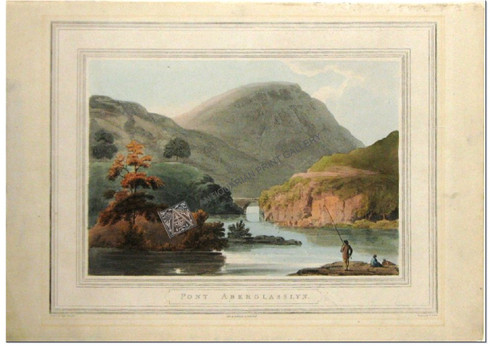 Loading... Please wait...
Loading... Please wait...All prices are in All prices are in USD
Categories
- Home
- Antique Prints
- Antique Print, Landscape, Wales, Aberglasslyn, Fishing
- Home
- Antique Prints
- Sport Antique Prints
- Antique Print, Landscape, Wales, Aberglasslyn, Fishing
- Home
- Antique Prints
- Rural Landscapes
- Antique Print, Landscape, Wales, Aberglasslyn, Fishing
Product Description
Antique Print, Rural Landscape, Pont Aberglassslyn, Wales, Aquatint
Title: Pont Aberglasslyn
Description: Original hand colored Aquatint etched by William Pickett (flourished late 18th/early 19th century) from a drawing by "Miss Smirke" (Mary Smirke, 1779-1853).
A Welsh Mountain landscape scene, with a bridge in the middle distance spanning calm waters, The Bridge is one of many Bridges in Wales, attached to folklore connected to the Devil. The left foreshore features a red jacketed fishermen and two ground-seated friends, with an autumnal colored tree on a land-spit in the left foreground.
Published by R. Bowyer, 87 Pall Mall, London c.1805, one of 18 views of "Picturesque Landscapes of England and Wales"
Condition: Printed on on Wove paper. Slight paper shadow, evidence of previous mat boards. No foxing. Original hand coloring.
Size of image/plate mark = 31.2cm x 23.5cm (121/2 x 91/3 inch)
Mary Smirke
The Royal Academy lists Miss Smirke as a British landscape painter & print-maker. She exhibited in the Royal Academy from 1809-18. She collaborated with Joseph Farrington (1747-1821) and employed as a copyist by Nathaniel Dance-Holland and SirThomas Lawrence. She translated "Don Quixote" by Miguel De Cervantes, which was published in 1818 with engravings after her father, Robert Smirke. (Judy Egerton, 'An Artist of Little Leisure: Mary Smirke, 1779- 1853', Country Life, 20 November 1969)
Pont Aberglasslyn
Situated in the parish of Nantmor landowners had benefited significantly from the land reclamation made possible by the construction of a sea wall. Known as the Cob, it was built by William Maddocks at Porthmadog in 1810. The Cob, across the Traeth Mawr estuary, is illustrated here. The Glasslyn estuary was tidal as far as Pont Aberglasslyn and the fisherman's path through the pass was used as a route to the coast. It gradually fell out of use and through erosion by the river, became impassable. This was resolved with the Cob, but then there is the local folklore, the Devil and a magician named Robin Ddu...











